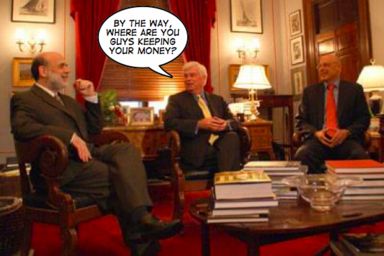 |
Wondering why the Lehman failure and Monday's 500 point DOW drop didn’t move the Fed to cut on Tuesday? Short term, a cut won’t help. Long term, cuts shrink an already very short runway to zero interest rate hell.
The effective Fed Funds rate shot up from 2.1% on Friday to 6% yesterday against a Fed Funds target rate of 2%. That’s because the Lehman bankruptcy left lenders to Lehman on the hook for hundreds of billions in losses. Now banks are afraid to lend to each other. We haven’t see that kind of dis-function since the crash of 1987.
The Fed is thinking, Why use up ammo when the bond markets can’t do anything with it anyway? More importantly, targeting rates (the price of money) doesn't work at such times as these. We explained to subscribers in Zero Bound Diaries: Is Bernanke Volcker's Mirror Image? Feb. 12, 2008 ($ubscription), that the Fed is going to stop targeting rates and start to target aggregates after they drop rates to 2%, as it turned out two months later in April 2008. We can’t see the rise in M3 because the government doesn’t report M3 anymore -- clever.
What it means is that the Fed has to risk moderate inflation now to try to avoid run-away inflation later. It's a big gamble that many countries throughout history have lost.
Quantity versus the price of money
The reason they are targeting aggregates is that as deflationary forces intensify with debt defaults, tightening lending standards, and a shrinking pool of credit-worthy borrowers, rate targeting (the price of money) becomes less effective as a policy tool to manage inflation. Targeting money aggregates (the quantity of money) becomes a more effective tool.
It’s the flip side of the problem that the Fed had in the late 1970s when inflation was very high. The Fed switched to targeting quantity over price then, between 1979 to 1982, because money price targeting is ineffective at the extremes of high and low inflation.
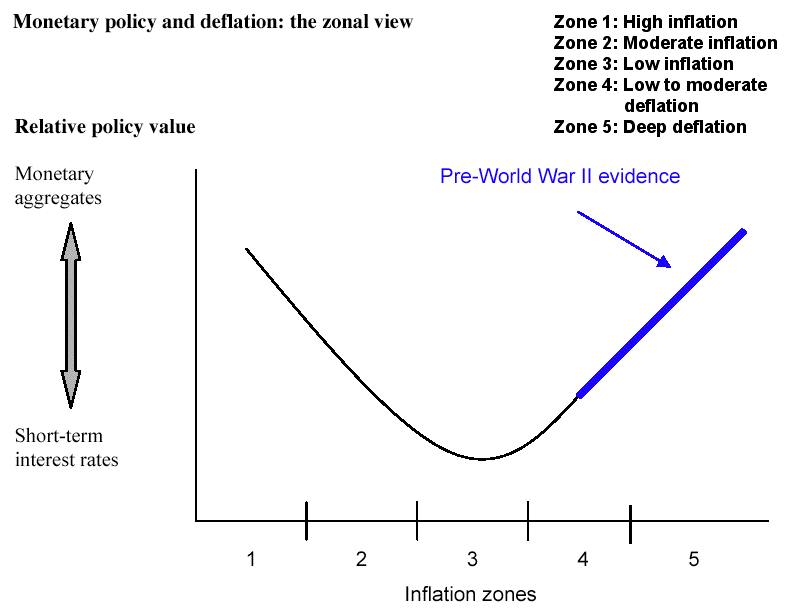
Instead of cutting rates, the Fed pumped in more cash.
Fed pumps $70 billion into financial system to ease stresses as markets tumble
Sept. 16, 2008 (AP)
Urgently trying to keep cash flowing amid a Wall Street meltdown, the Federal Reserve on Tuesday pumped another $70 billion into the nation's financial system to help ease credit stresses.The Federal Reserve Bank of New York's action came in two operations in which $50 billion and then another regularly scheduled $20 billion were injected in temporary reserves
The name of the game is to maintain the money supply as needed to keep inflation above zero percent because for a net debtor very ugly things happen at the zero bound. Sept. 16, 2008 (AP)
Urgently trying to keep cash flowing amid a Wall Street meltdown, the Federal Reserve on Tuesday pumped another $70 billion into the nation's financial system to help ease credit stresses.The Federal Reserve Bank of New York's action came in two operations in which $50 billion and then another regularly scheduled $20 billion were injected in temporary reserves
Not like this:
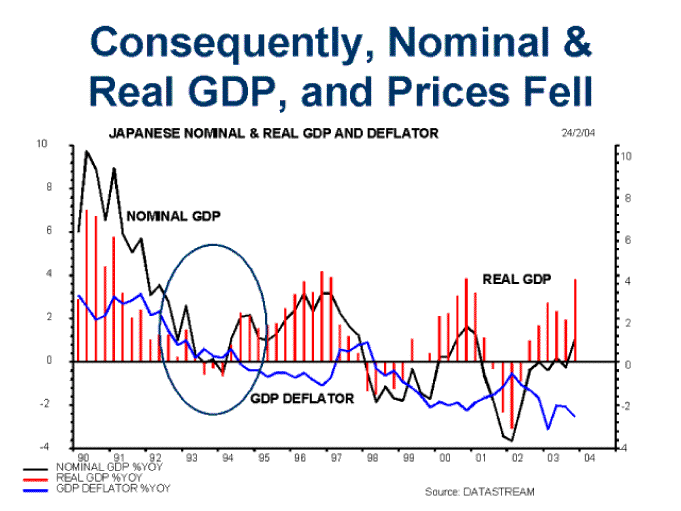
Net creditor at the zero bound: Japan 1990 - 2005
Currency strengthens, capital flows in, deflation dynamics set in
...or this:
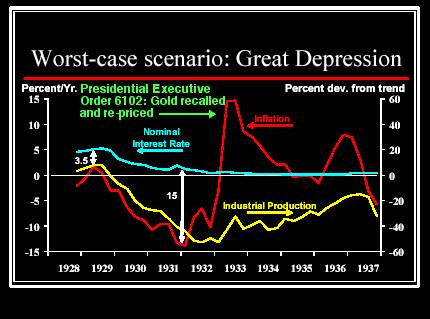
Net creditor at the zero bound: US 1927 - 1937
Currency strengthens, capital flows in, deflation dynamics set in
Like this:
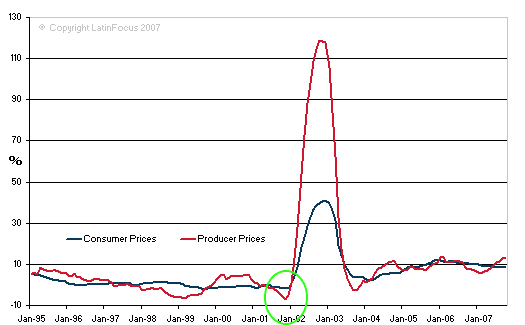
Net debtor at the zero bound: Argentina 1995 - 2008
Currency weakens, capital flees, inflation spikes
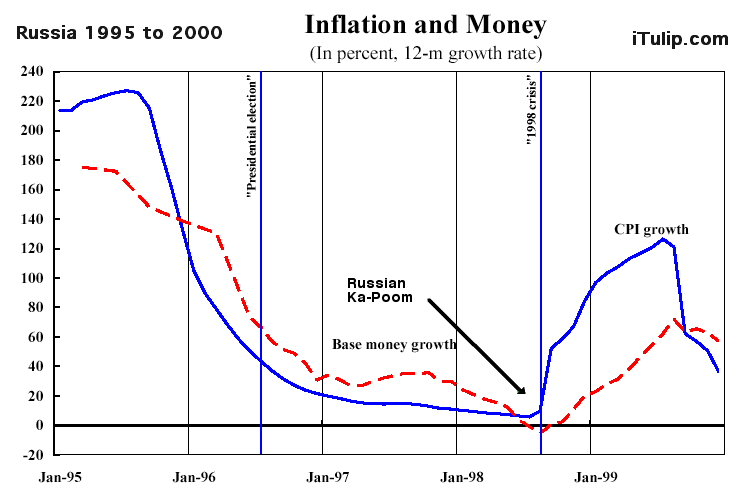
Net debtor at the zero bound: Russia 1995 - 2000
Currency weakens, capital flees, inflation spikes
Of course, the US has many advantages over both of these net debtor cases:
- US foreign debt is denominated in US currency so it does not need to sell dollars to repay debt in another currency
- Most of the debt is long term so it does not need to be rolled over
- Foreign governments not private institutions now hold the majority of US debt so the foreign trade in US debt is less volatile but on the other hand more political (See China paper urges new currency order after "financial tsunami")
- The US has a long history of political stability and come-backs from economic crisis so investors tend to believe that the US will quickly recover it s economic footing
These factors will determine the result of the Ka-Poom disinflation-inflation process by degree but not the fundamental dynamic. The US has higher inflation and interest rates in its future. The questions are how high and when.
Expectations drive markets short term, reality drives them long term
Wait a minute, you say. Isn’t the dollar shooting up as money pours back into the US from emerging markets? Don’t forget the old adage, there’s nothing harder than emerging money from an emerging market during an emergency. Right?
The US recovered from 2004 and 2006 because of growth driven by the housing bubble and foreign lending. Did you know 70% of the US fiscal – not trade – deficit was financed by foreign lending in 2003? True fact. What does a government do if it can't borrow the money? Three options: cut spending, thereby increasing unemployment, raise taxes, thereby cutitng demand, or print money, thereby wrecking the purchasing power of money – including tax revenues. That's how hyperinflations happen – the more the government prints to pay fixed expenses the more it has to print to pay fixed expenses.
The US has been a safe haven for capital for decades. That changed with the terminal demise of the FIRE Economy starting in early 2007, but the global habit of thinking of the US the other way, as if it still were a safe haven, has not.
Don’t be fooled by this bounce in the dollar. As soon as market participants realize that it cannot be sustained, it's curtains for 35 years of the borrow-and-spend FIRE Economy.
Different this time for the US, same old same old for all net debtors in trouble throughout history
In this global contraction, will Japan, China, Russia, Brazil et al be able to continue to finance America’s twin fiscal and trade deficits? Not if they are in recession, too, because – and this is key – demand from the US for their exports are falling off a cliff because the housing bubble demand engine died, an engine that directly via credit expansion and indirectly via purchases of consumer goods to fill houses, justified the foreign lending in the first place.
Now unemployment is rising, credit and incomes are shrinking, and the future driver for the US economy in the wings that I am promoting – investment in transportation, energy, and communications infrastructure – has not yet gotten off the ground.
The US is now like any other net debtor in an economic crisis without a way to grow its way out of debt.
This time the US is in a position similar to Germany in 1930, Russia in the early 1990s or Argentina in the early 2000s, dependent on borrowing from countries that lost their ability to lend due to their own problems. Such countries become victims of global capital flight in a worldwide financial and economic crisis when a falling global economic tide lowers all ships.
I know it’s hard to get your head around as an American because you love your country but it’s time for you to start to think of the US as at risk of capital flight versus a safe haven.
How much faith do you have in the Fed?
As we mentioned in Future inflation fears topple TIPS, by reducing exposure to inflation-index bonds the US government is not preparing for deflation.
A once-in-a-century crash may occur if the Fed botches this and we get too close to the zero bound before the economy grows again. At this point in the race between the disinflationary impact of recession and debt deflation and the inflationary impact of moving all manner of worthless assets onto the Fed’s and Federal Government’s balance sheets, disinflation may be winning. At some point before the zero bound is reached, never mind the point of actual deflation (negative inflation rate such as -2%), if the US experience is like any other net debtor's in history a currency accident will occur as global financial markets realize that the US position as a safe haven relative to its trade partners has reversed. A rapid, self-reinforcing process of capital flight and dollar depreciation that we call “Poom” will begin.
The Fed knows this. It is doing everything it can to keep inflation above zero and maintain dry powder, and that means keeping the Fed Funds rate target over 2%.
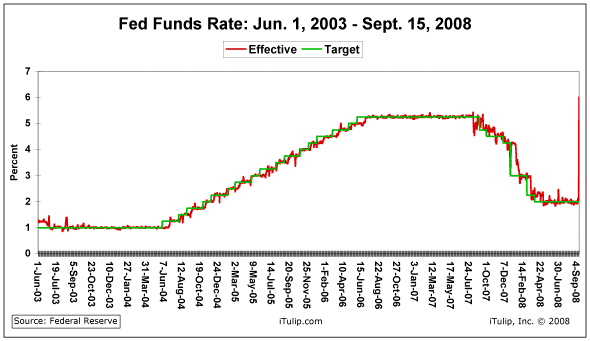
Fed Funds effective rate spikes to 6% from 2.1% versus target rate of 2%
the day of the Lehman bankruptcy
iTulip Select: The Investment Thesis for the Next Cycle™
__________________________________________________
To receive the iTulip Newsletter or iTulip Alerts, Join our FREE Email Mailing List
Copyright © iTulip, Inc. 1998 - 2007 All Rights Reserved
All information provided "as is" for informational purposes only, not intended for trading purposes or advice. Nothing appearing on this website should be considered a recommendation to buy or to sell any security or related financial instrument. iTulip, Inc. is not liable for any informational errors, incompleteness, or delays, or for any actions taken in reliance on information contained herein. Full Disclaimer



Comment